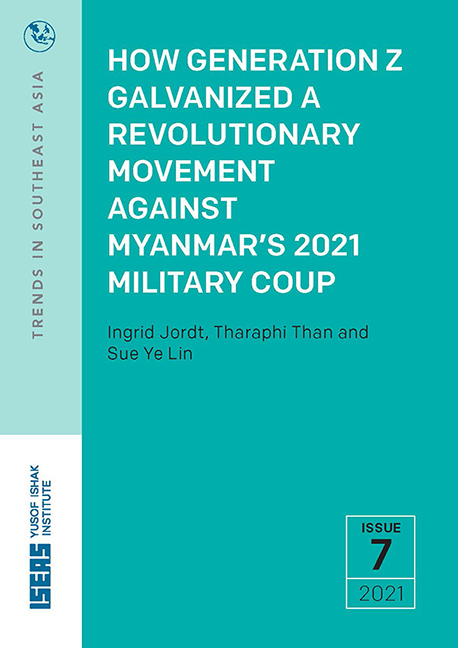How Generation Z Galvanized a Revolutionary Movement against Myanmar’s 2021 Military Coup
Published online by Cambridge University Press: 08 October 2021
Summary
EXECUTIVE SUMMARY
• On 1 February 2021, under the command of General Min Aung Hlaing, Myanmar's military initiated a coup, apparently drawing to a close Myanmar's ten-year experiment with democratic rule. State Counsellor Aung San Suu Kyi and President Win Myint were arrested along with other elected officials.
• Mass protests against the coup ensued, led by Gen Z youths who shaped a values-based democratic revolutionary movement that in character is anti-military regime, anti-China influence, anti-authoritarian, anti-racist, and anti-sexist. Women and minorities have been at the forefront, organizing protests, shaping campaigns, and engaging sectors of society that in the past had been relegated to the periphery of national politics. The protests were broadcast to local and international audiences through social media.
• Simultaneously, a civil disobedience movement (CDM) arose in the shape of a massive strike mostly led by civil servants. CDM is non-violent and acephalous, a broad “society against the state” movement too large and diffuse for the military to target and dismantle. Semi-autonomous administrative zones in the name of Pa-a-pha or civil administrative organizations emerged out of spontaneously organized neighbourhood watches at the ward and village levels, effectively forming a parallel governance system to the military state.
• Anti-coup protests moved decisively away from calls for the release of Aung San Suu Kyi and other elected political leaders, or for a return to democracy under the 2008 constitution. Instead, it evolved towards greater inclusivity of all Myanmar peoples in pursuit of a more robust federal democracy. A group of fifteen elected parliamentarians, representing the ideals of Gen Z youths, formed a shadow government called the Committee Representing the Pyidaungsu Hluttaw (CRPH) on 5 February 2021. On 1 March the CRPH declared the military governing body, the State Administrative Council (SAC), a “terrorist group”, and on 31 March, it declared the military's 2008 constitution abolished.
• Gen Z's protests have accomplished what has been elusive to prior generations of anti-regime movements and uprisings. They have severed the Bamar Buddhist nationalist narrative that has gripped state society relations and the military's ideological control over the political landscape, substituting for it an inclusive democratic ideology.
- Type
- Chapter
- Information
- How Generation Z Galvanized a Revolutionary Movement against Myanmar's 2021 Military Coup , pp. vii - viiiPublisher: ISEAS–Yusof Ishak InstitutePrint publication year: 2021



